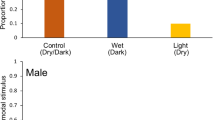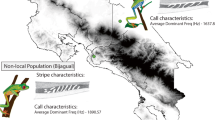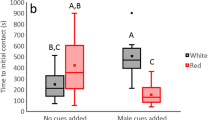Abstract
Many anuran amphibians are challenged with the detection of courtship signals in noisy chorus environments. Anurans and other animals partially solve this discrimination challenge by employing auditory mechanisms such as grouping sounds by frequency, time, or spatial location. Animals are also known to employ visual cues as a mechanism of improving auditory signal detection. In this study, we examined the effect of acoustic and visual stimuli on female mate choice preferences in the green tree frog, Hyla cinerea. We used a series of two choice playback tests and added a robotic frog, with an inflatable vocal sac, to test interactions among visual and acoustic signal components. Females preferred vocalizations with faster call rates (i.e., high energy cost) and lower call frequencies (i.e., larger males). When call properties were held equal, females discriminated against an acoustic only stimulus in favor of the combined acoustic/visual multimodal signal. A visual component did not, however, increase the attractiveness of an otherwise unattractive (high-frequency) acoustic signal. Thus, female green tree frogs integrate the visual display into the acoustic communication system and males that are visually accessible can increase their probability of mating success. Visual accessibility, however, is unlikely to improve mating success for small males (high-frequency callers).
Significance statement
Animal communication signals are often complex and communicated in multiple sensory channels (e.g., auditory + visual). Female choice is known to be an important mechanism driving signal evolution. Thus, for complex mating signals, a first step in understanding their evolution is to test how females respond to various combinations of components. Here, we tested female mate choice in the green tree frog, H. cinerea, using a combination of audio playbacks and a robotic frog as the visual component. When the audio signal was standardized, females preferred a signal enhanced by a robotic frog. The robotic frog did not increase female responses to an unattractive call (indicative of a small male), however. These results suggest that visual accessibility can improve a male’s chance of mating, but this advantage is context dependent and does not extend to smaller males.




Similar content being viewed by others
References
Akre KL, Ryan MJ (2010) Complexity increases working memory for mating signals. Curr Biol 20:502–505
Baldwin J, Johnsen S (2009) The importance of color in mate choice of the blue crab Callinectes sapidus. J Exp Biol 212:3762–3768
Bee MA (2012) Sound source perception in anuran amphibians. Curr Opin Neurobiol 22:301–310
Bee MA (2015) Treefrogs as animal models for research on auditory scene analysis and the cocktail party problem. Int J Psychophysiol 95:216–237
Bee MA, Micheyl C (2008) The “cocktail party problem”: what is it? How can it be solved? And why should animal behaviorists study it? J Comp Psychol 122:235–251
Bradbury JW, Vehrencamp SL (1998) Principles of animal communication. Sinauer, Sunderland, MA
Bronkhorst AW (2000) The cocktail party phenomenon: a review of research on speech intelligibility in multiple-talker conditions. Acustica 86:117–128
Buerkle NP, Schrode KM, Bee MA (2014) Assessing stimulus and subject influences on auditory evoked potentials and their relation to peripheral physiology in green treefrogs (Hyla cinerea). Comp Biochem Physiol A 178:68–81
Caldwell MS, Bee MA (2014) Spatial hearing in Cope’s gray treefrog: I. Open and closed loop experiments on sound localization in the presence and absence of noise. J Comp Physiol A 200:265–284
Caldwell MS, Lee N, Schrode KM, Johns AR, Christensen-Dalsgaard J, Bee MA (2014) Spatial hearing in Cope’s gray treefrog: II. Frequency-dependent directionality of the amplitude and phase of tympanum vibrations. J Comp Physiol A 200:285–304
Cherry EC (1953) Some experiments on the recognition of speech, with one and with two ears. J Acoust Soc Am 25:975–979
Coleman SW, Patricelli GL, Borgia G (2004) Variable female preferences drive complex male displays. Nature 428:742–745
Fain GL, Matthews HR, Cornwall MC, Koutalos Y (2001) Adaptation in vertebrate photoreceptors. Physiol Rev 81:117–151
Farris HE, Ryan MJ (2011) Relative comparisons of call parameters enable auditory grouping in frogs. Nat Commun 2:410
Farris HE, Rand AS, Ryan MJ (2002) The effects of spatially separated call components on phonotaxis in túngara frogs: evidence for auditory grouping. Brain Behav Evol 60:181–188
Gerhardt HC (1987) Evolutionary and neurobiological implications of selective phonotaxis in the green treefrog, Hyla cinerea. Anim Behav 35:1479–1489
Gerhardt HC, Höbel G (2005) Mid-frequency suppression in the green treefrog (Hyla cinerea): mechanisms and implications for the evolution of acoustic communication. J Comp Physiol A 191:707–714
Gerhardt HC, Huber F (2002) Acoustic communication in insects and anurans: common problems and diverse solutions. University of Chicago Press, Chicago
Gerhardt HC, Klump GM (1988) Masking of acoustic signals by the chorus background noise in the green tree frog: a limitation on mate choice. Anim Behav 36:1247–1249
Greenfield MD, Schul J (2008) Mechanisms and evolution of synchronous chorusing: emergent properties and adaptive functions in Neoconocephalus katydids (Orthoptera: Tettigoniidae). J Comp Psychol 122:289–297
Guilford T, Dawkins MS (1991) Receiver psychology and the evolution of animal signals. Anim Behav 42:1–14
Hebets EA, Papaj DR (2005) Complex signal function: developing a framework of testable hypotheses. Behav Ecol Sociobiol 57:197–214
Hebets EA, Cuasay K, Rivlin PK (2006) The role of visual ornamentation in female choice of a multimodal male courtship display. Ethology 112:1062–1070
Hebets EA, Stafstrom JA, Rodriguez RL, Wilgers DJ (2011) Enigmatic ornamentation eases male reliance on courtship performance for mating success. Anim Behav 81:963–972
Hicks RE, Larned A, Borgia G (2013) Bower paint removal leads to reduced female visits, suggesting bower paint functions as a chemical signal. Anim Behav 85:1209–1215
Hirschman W, Hödl W (2006) Visual signaling in Phrynobatrachus krefftii Boulenger, 1909 (Anura: Ranidae). Herpetologica 62:18–27
Höbel G (2010) Interaction between signal timing and signal feature preferences: causes and implications for sexual selection. Anim Behav 79:1257–1266
Hödl W, Amézquita A (2001) Visual signaling in anuran amphibians. In: Ryan MJ (ed) Anuran communication. Smithsonian Institution Press, Washington DC, pp. 121–141
Klein BA, Stein J, Taylor RC (2012) Robots in the service of animal behavior. Commun Integr Biol 5:466–472
Lea AL, Ryan MJ (2015) Irrationality in mate choice revealed by túngara frogs. Science 349:964–966
Lettvin JY, Maturana HR, McCulloch WS, Pitts WH (1959) What the frog’s eye tells the frog’s brain. P IRE 47:1940–1951
Lombardo SR, Mackey E, Tang L, Smith BR, Blumstein DT (2008) Multimodal communication and spatial binding in pied currawongs (Strepera graculina). Anim Cogn 11:675–682
Macedonia JM, Clark DL, Riley RG, Kemp DJ (2013) Species recognition of color and motion signals in Anolis grahami: evidence from responses to lizard robots. Behav Ecol 24:846–852
McLennan DA (2003) The importance of olfactory signals in the gasterosteid mating system: sticklebacks go multimodal. Biol J Linn Soc 80:555–572
Narins PM, Hödl W, Grabul DS (2003) Bimodal signal requisite for agonistic behavior in a dart-poison frog, Epipedobates femoralis. Proc Natl Acad Sci U S A 100:577–580
Nityananda V, Bee MA (2011) Finding your mate at a cocktail party: frequency separation promotes auditory stream segregation of concurrent voices in multi-species frog choruses. PLoS One 6:e21191
Oldham RS, Gerhardt HC (1975) Behavioral isolating mechanisms of the treefrogs Hyla cinerea and H. gratiosa. Copeia 1975:223–231
Partan S, Marler P (1999) Communication goes multimodal. Science 283:1272–1273
Partan SR, Larco CP, Owens MJ (2009) Wild tree squirrels respond with multisensory enhancement to conspecific robot alarm behaviour. Anim Behav 77:1127–1135
Patricelli GL, Krakauer AH (2009) Tactical allocation of effort among multiple signals in sage grouse: an experiment with a robotic female. Behav Ecol 21:97–106
Pauly GB, Bernal XE, Rand AS, Ryan MJ (2006) The vocal sac increases call rate in the túngara frog Physalaemus pustulosus. Physiol Biochem Zool 79:708–719
Preininger D, Boeckle M, Freudmann A, Starnberger I, Sztatecsny M, Hödl W (2013) Multimodal signaling in the small torrent frog (Micrixalus saxicola) in a complex acoustic environment. Behav Ecol Sociobiol 67:1449–1456
Rand AS, Dudley R (1993) Frogs in helium: the anuran vocal sac is not a cavity resonator. Physiol Zool 66:793–806
Reichert MS, Galante H, Höbel G (2014) Female gray treefrogs, Hyla versicolor, are responsive to visual stimuli but unselective of stimulus characteristics. J Exp Biol 217:3254–3262
Rowe C (1999) Receiver psychology and the evolution of multicomponent signals. Anim Behav 58:921–931
Rundus AS, Owings DH, Joshi SS, Chinn E, Giannini N (2007) Ground squirrels use an infrared signal to deter rattlesnake predation. Proc Natl Acad Sci U S A 104:14372–14376
Ryan MJ (2001) Anuran communication. Smithsonian Institution Press, Washington DC
Ryan MJ, Guerra MA (2014) The mechanism of sound production in túngara frogs and its role in sexual selection and speciation. Curr Opin Neurobiol 28:54–59
Schrode KM, Bee MA (2015) Evolutionary adaptations for the temporal processing of natural sounds by the anuran peripheral auditory system. J Exp Biol 218:837–848
Schwartz JJ, Buchanan BW, Gerhardt HC (2001) Female mate choice in the gray treefrog (Hyla versicolor) in three experimental environments. Behav Ecol Sociobiol 49:443–455
Starnberger I, Preininger D, Hödl W (2014a) The anuran vocal sac: a tool for multimodal signaling. Anim Behav 97:281–288
Starnberger I, Preininger D, Hödl W (2014b) From uni- to multimodality: towards an integrative view on anuran communication. J Comp Physiol A 200:777–787
Sumby WH, Pollack I (1954) Visual contribution to speech intelligibility in noise. J Acoust Soc Am 26:212–215
Taylor RC, Ryan MJ (2013) Interactions of multisensory components perceptually rescue túngara frog mating signals. Science 341:273–274
Taylor RC, Buchanan BW, Doherty JL (2007) Sexual selection in the squirrel treefrog Hyla squirella: the role of multimodal cue assessment in female choice. Anim Behav 74:1753–1763
Taylor RC, Klein BA, Stein J, Ryan MJ (2008) Faux frogs: multimodal signalling and the value of robotics in animal behaviour. Anim Behav 76:1089–1097
Taylor RC, Klein BA, Ryan MJ (2011) Inter-signal interaction and uncertain information in anuran multimodal signals. Curr Zool 57:153–161
Uitenbroek DG (1997) SISA Binomial. D.G. Uitenbroek, Southampton, http://www.quantitativeskills.com/sisa/distributions/binomial.htm.
Vélez A, Bee MA (2011) Dip listening and the cocktail party problem in grey treefrogs: signal recognition in temporally fluctuating noise. Anim Behav 82:1319–1327
Vélez A, Höbel G, Gordon NM, Bee MA (2012) Dip listening or modulation masking? Call recognition by green treefrogs (Hyla cinerea) in temporally fluctuating noise. J Comp Physiol A 198:891–904
Ward JL, Buerkle NP, Bee MA (2013) Spatial release from masking in a biologically relevant temporal pattern discrimination task in gray treefrogs. Hear Res 306:63–75
Wilczynski W, Rand SA, Ryan MJ (1999) Female preferences for temporal order of call components in the túngara frog: a Bayesian analysis. Anim Behav 58:841–851
Wiley RH (1994) Errors, exaggeration, and deception in animal communication. In: Real L (ed) Behavioral mechanisms in evolutionary ecology. University of Chicago Press, Chicago, pp. 157–189
Wiley RH (2015) Noise matters: the evolution of communication. Harvard University Press, Cambridge, MA
Wollerman L (1999) Acoustic interference limits call detection in a neotropical frog Hyla ebraccata. Anim Behav 57:529–536
Acknowledgments
Ron Gutberlet provided helpful feedback on an early draft of the manuscript and we dedicate this work to his memory. We are grateful to Tyler Bowling for his help with fieldwork and data collection. We thank Kyle Summers and two anonymous referees for valuable comments on the manuscript. Funding was provided by the Salisbury University Henson School of Science and a Guerrieri summer research internship to TB. Gerlinde Höbel generously provided preserved specimens of green tree frogs used to cast molds for the model frogs.
Author information
Authors and Affiliations
Corresponding author
Ethics declarations
Ethical standards
Handling and toe clip procedures were conducted in accordance with The American Society of Ichthyologists and Herpetologists’ “Guidelines for Use of Live Amphibians and Reptiles in Field and Laboratory Research.” All experiments were conducted in accordance with Salisbury University guidelines and approved by the SU Institutional Animal Care and Use Committee (Protocol # SU 0036).
Conflict of interest
The authors declare they have no conflict of interest.
Additional information
Communicated by K. Summers
Rights and permissions
About this article
Cite this article
Laird, K.L., Clements, P., Hunter, K.L. et al. Multimodal signaling improves mating success in the green tree frog (Hyla cinerea), but may not help small males. Behav Ecol Sociobiol 70, 1517–1525 (2016). https://doi.org/10.1007/s00265-016-2160-9
Received:
Revised:
Accepted:
Published:
Issue Date:
DOI: https://doi.org/10.1007/s00265-016-2160-9




